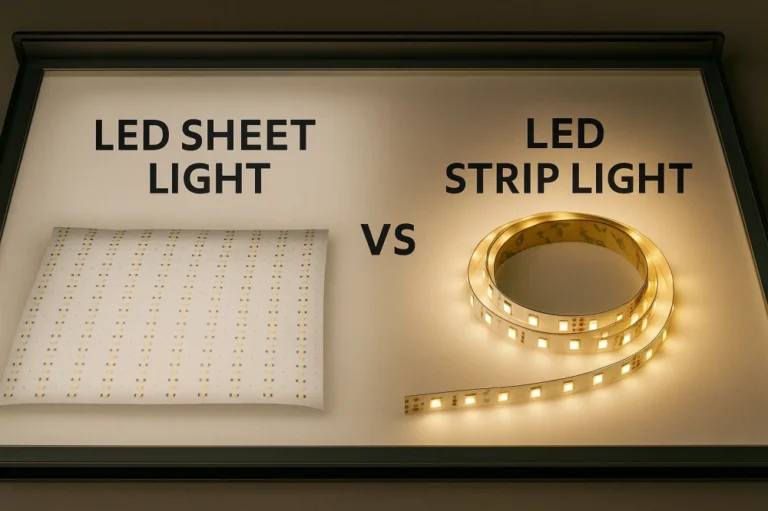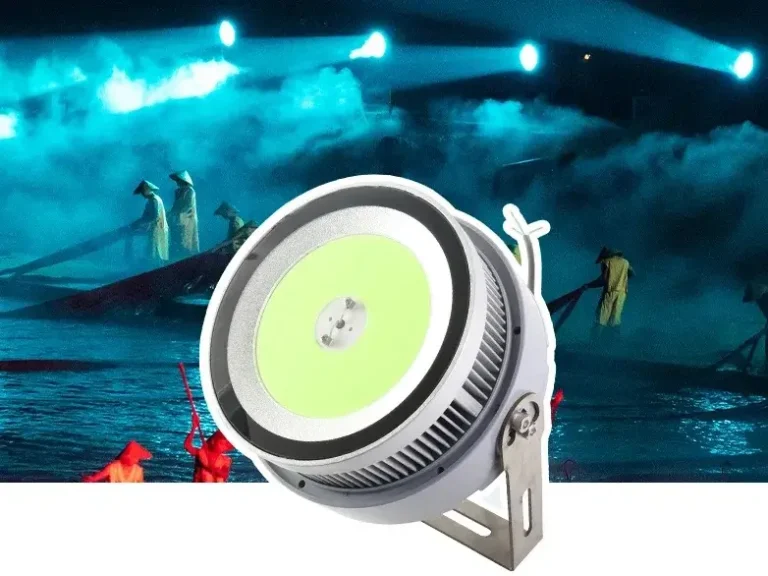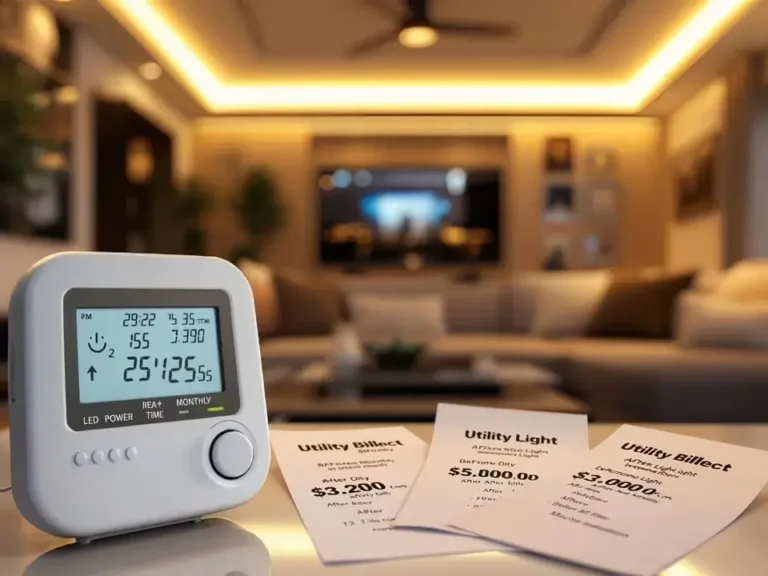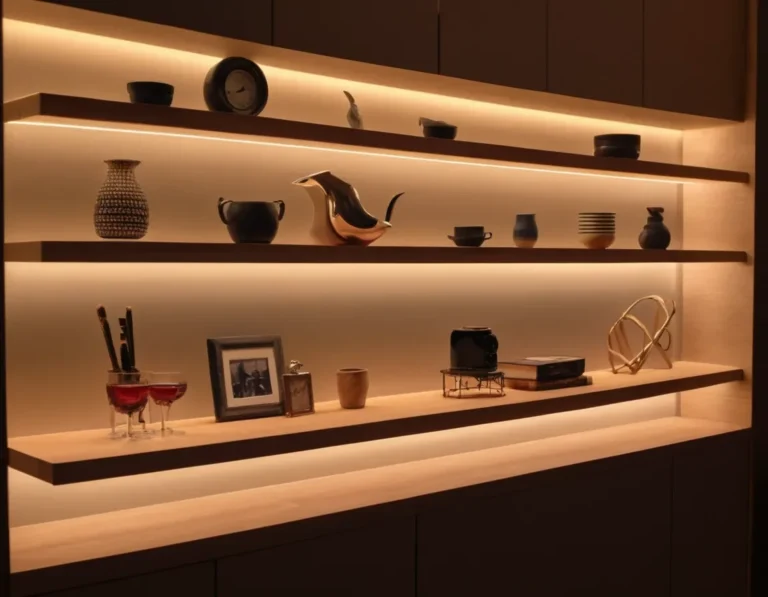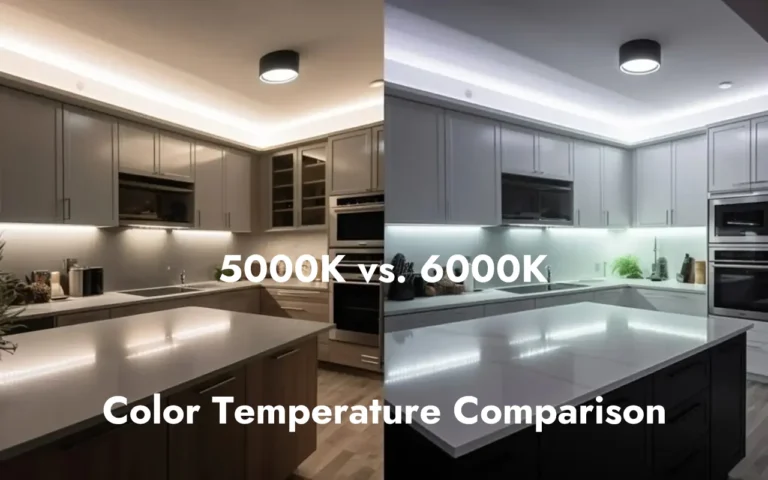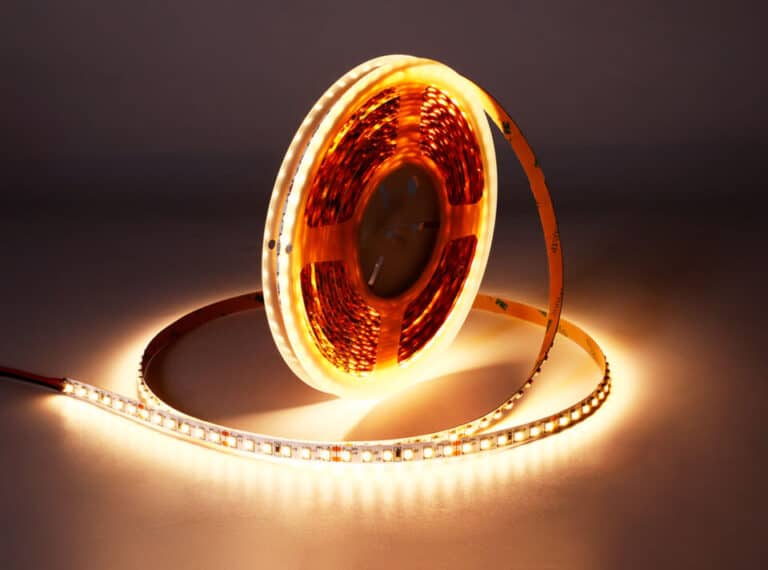LED灯带的宽度、长度和LED芯片类型多种多样,使其适用于住宅和商业照明。在照明项目中,选择合适的LED灯带宽度可能是一个令人头疼的问题。您是否曾为选择合适的LED灯带尺寸而感到不知所措?让我们仔细看看不同的宽度选项,找到最适合您照明需求的灯带。
LED 灯带的尺寸和宽度种类繁多。单排 LED 灯带的宽度通常在 3 毫米到 15 毫米之间。相比之下,多排 LED 灯带的宽度可达 120 毫米。选择合适的 LED 灯带宽度对于确保良好的散热、灵活的安装以及其他因素至关重要。此外,LED 芯片或 SMD 的尺寸也是影响 LED 灯带宽度的另一个关键因素。
了解每种 LED 灯带宽度如何影响安装和性能,是做出正确选择的关键。让我们深入了解细节!
LED灯带的宽度是多少?
宽度 LED灯带 指的是其物理宽度,具体来说是PCB(印刷电路板)的宽度。LED灯带的结构由多个LED组成,这些LED以规则的图案排列在柔性电路板(PCB)上。因此,LED灯带的宽度本质上指的是PCB的宽度,通常以毫米(mm)为单位,表示灯带基材的尺寸。
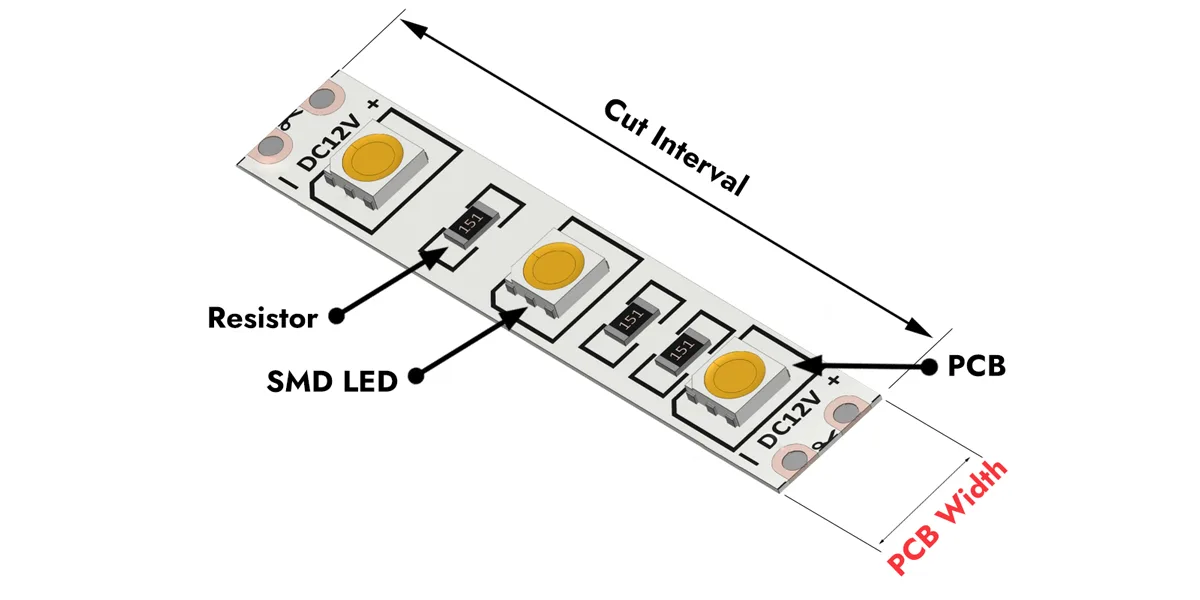
在为各种项目选择和安装 LED 灯带时,灯带的宽度是一个重要的考虑因素。较宽的灯带通常可以容纳更多 LED,从而提供更明亮的照明和更好的散热效果,而较窄的灯带可能更适合空间有限或有特定设计要求的安装。
值得注意的是,LED 灯带的宽度各不相同。例如,单排 LED 灯带在整个长度上只有一排 LED 芯片,宽度通常在 1 毫米到 15 毫米之间。而多排 LED 灯带则在整个 PCB 上有多排 LED 芯片。这使得它们比单排 LED 灯带更宽,宽度可达 120 毫米。这些 LED 灯带可以是双排、三排、四排、五排或更多排。
当然,所有宽度和 LED 行数都是可定制的,具体取决于制造商和您的预期应用。
为什么要考虑LED灯带的宽度?
LED 灯带的宽度是一个至关重要的考虑因素。合适的宽度选择不仅关乎美观,还会显著影响亮度、照度、散热、物理空间占用以及安装灵活性。让我们来探讨一下具体原因。
1.亮度和照度:LED 灯带的宽度会影响其亮度和整体照度。较宽的灯带通常可以容纳更多 LED,从而产生更高的光输出,但同时也会消耗更多能源。如果您需要明亮的照明,较宽的灯带可能更合适。相反,较窄的灯带可以产生更柔和或更聚焦的光线。
2.散热:LED 灯带在工作时会产生热量。将 LED 产生的热量传导至 PCB 电路板并将其散发到周围环境中,对于保持灯带冷却至关重要。在这种情况下,较宽的 LED 灯带可以充当散热器,吸收并散发 LED 产生的热量。与较窄的 PCB 电路板相比,较宽的 PCB 电路板效率更高。
3. 空间设计与美学:LED 灯带通常用于装饰照明或重点照明。LED 灯带的宽度会影响整个空间的视觉效果以及与整体设计的融合程度。例如,较宽的灯带可能更适合营造大胆醒目的效果,而较窄的灯带则可能营造更简约或低调的外观。
4.安装灵活性:如果您的安装空间非常狭窄,安装较宽的 LED 灯带可能会比较困难。因此,务必检查 LED 灯带的宽度,以确保其适合您的安装空间。此外,较窄的灯带更适合安装在角落或边缘,因为它们易于弯曲。
5.配件兼容性:LED 灯带的宽度对于确保与安装支架的兼容性至关重要, LED连接器, 和 其他配件。这些配件通常设计用于适合特定的灯带宽度,因此选择合适的宽度可确保良好的连接性和易于安装。
6. LED 铝通道兼容性:添加时 铝通道 将灯带或硅胶扩散器安装到 LED 灯带时,灯带的宽度是一个关键考虑因素。添加 LED 灯带槽可以提供柔和均匀的光线输出,但如果灯带宽度不理想,可能会出现安装问题。在这种情况下,您必须考虑槽的内径与 LED 灯带宽度之间的兼容性。例如,10 毫米的 LED 灯带无法安装到 5 毫米的铝槽或硅胶扩散器中。有关 LED 铝型材的更多信息,请阅读“LED灯带铝型材”
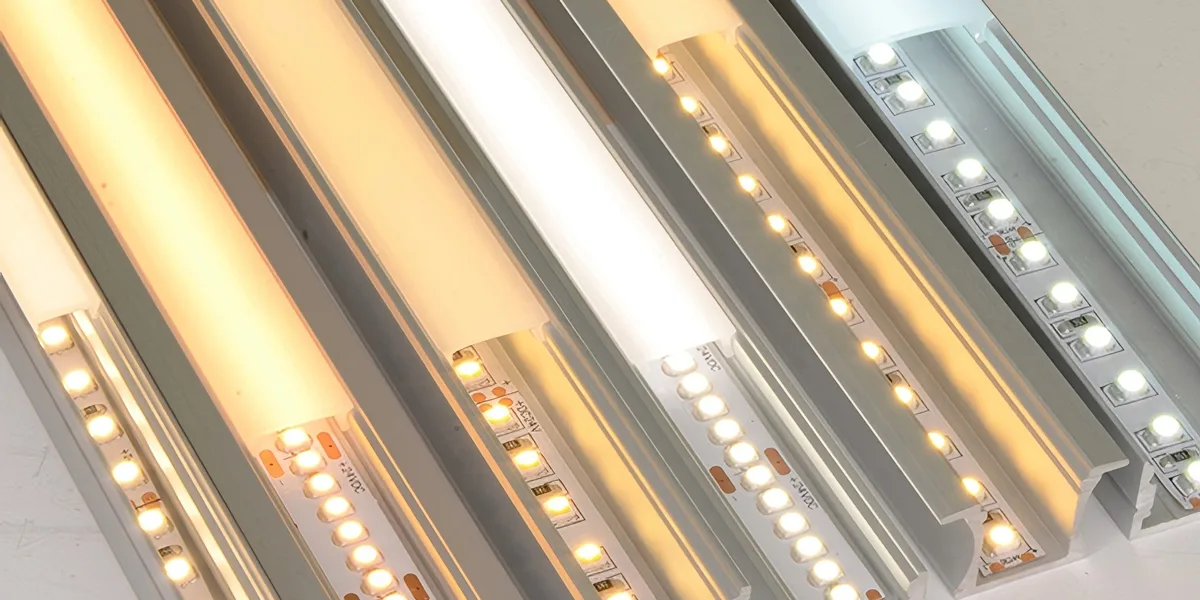
LED灯带的标准宽度是多少?
LED灯带最常见的标准宽度是8毫米、10毫米和12毫米。这也是最常用的三种宽度。LED灯带的宽度因品牌而异,也取决于LED灯带的类型和LED芯片的尺寸。
8毫米LED灯带:8 毫米 LED 灯带非常适合安装在狭窄、不显眼的区域,满足了如今对重点照明、橱柜下照明或家具照明的新兴需求。如此窄的宽度既能满足对柔和照明的需求,又不会占用过多空间。这种宽度也为无限的创意应用提供了可能,例如安装在橱柜内部或照明空间有限的楼梯沿线。灯带的低可见度增强了照明效果,同时又不影响整体装饰风格。
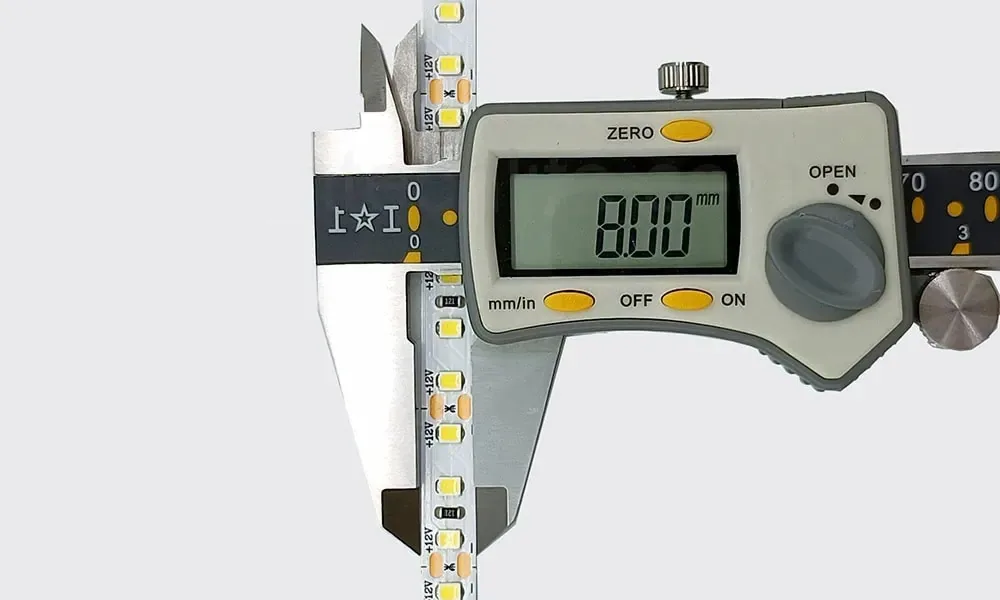
10mm LED灯带:10 毫米 LED 灯带通常用于普通照明项目。它们亮度高,常用于建筑照明、凹槽照明以及住宅和商业用途的装饰照明。此外,无论是用于家居重点照明还是零售店的功能性照明,10 毫米灯带都能轻松适应各种使用环境。这种多功能性还延伸到颜色选择,许多 10 毫米 LED 灯带提供 RGB 和可调白光版本,让用户能够根据自己的喜好定制照明。
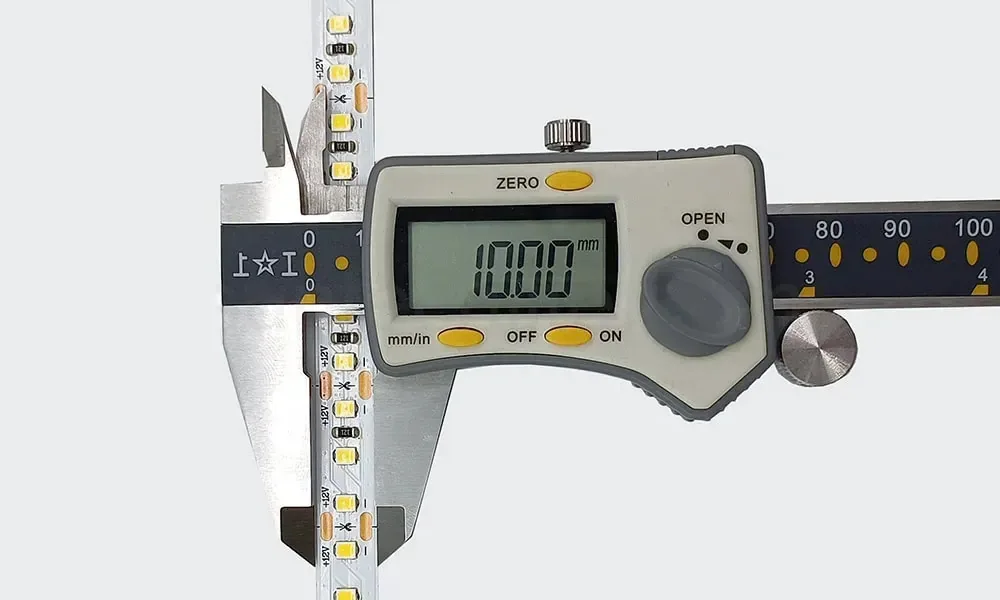
12mm LED灯带:12 毫米 LED 灯带略宽,通常光输出更高。它们通常用于需要更明亮、更强大照明解决方案的应用,例如户外照明或更大规模的安装。这种宽度可以实现更高的 LED 密度、亮度和均匀的光分布。12 毫米 LED 灯带是建筑照明的理想选择,主要是因为在建筑照明中,美观与功能的结合对于突出关键特征和创造兴趣点至关重要。
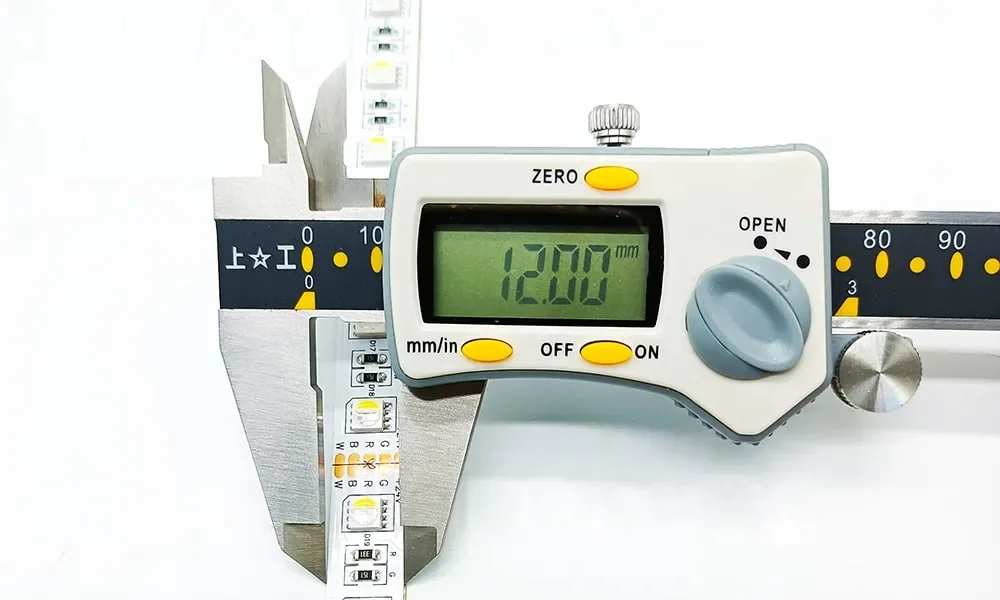
15毫米及更宽的LED灯带:15 毫米及更宽的 LED 灯带具有更高的 LED 密度和亮度。它们适用于商业照明和大型安装。这些灯带提供均匀的照明,阴影极小,是建筑和标牌项目的理想选择。更宽的灯带可以容纳更多 LED,并有助于更好地散热,这对于防止长时间使用时过热至关重要。因此,它们足以满足对性能一致性和可靠性至关重要的专业应用需求。
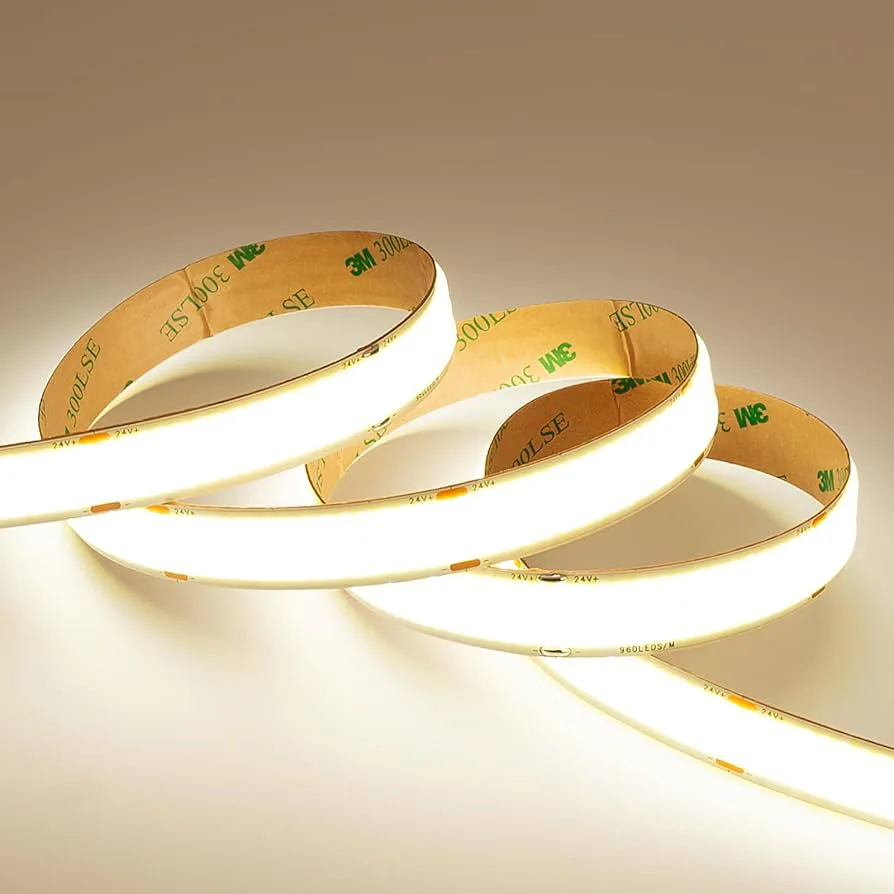
15mm宽超亮无点COB LED灯带
模型: FYX15T1920C
每米 LED 芯片数量: 1920芯片
国际广播电台: >90
PCB宽度: 15毫米
色温: 3000K/4000K/6000K
输入电压: DC24V
每米功率: 25瓦
可切割长度: 20.67毫米
防水版本: IP20/IP65
保修单: 3年
超窄LED灯带:宽度为 3 毫米、4 毫米和 5 毫米的 LED 灯带通常被称为超窄 LED 灯带,非常适合超薄且隐蔽的照明需求。其紧凑的尺寸使其易于安装在狭窄的空间,例如橱柜边缘、展示柜和建筑结构。这些灯带非常适合极简主义设计,在隐藏光源的同时,仍能提供干净优雅的照明。
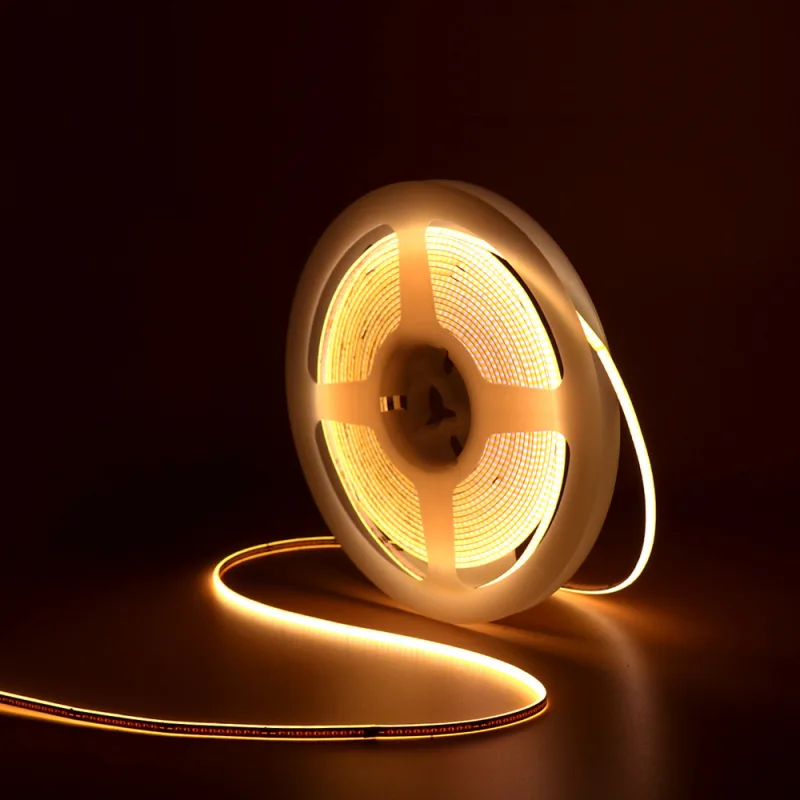
超窄COB LED灯带
主要型号: FYX04T400C
每米 LED 数量: 400芯片(三安)
PCB宽度选项: 3毫米/4毫米/5毫米
颜色选项: 2700K/3000K/4000K/6000K
国际广播电台: >90
输入电压: DC5V/DC12V/DC24V
每米功率: 5.5瓦/10瓦
效率: 90–110 流明/瓦
IP等级选项: IP20/IP54/IP65/IP67/IP68
保修单: 3年

很多人都有一个共同的问题:所有LED灯带的宽度都一样吗?答案是否定的。 为了满足不同的应用需求,并非所有 LED 灯带都具有相同的 PCB 宽度。在狭窄的安装空间(例如橱柜内部)中,较宽的 LED 灯带由于空间有限,难以隐藏。如果您想在狭窄的缝隙中添加 LED 照明,则可以使用较窄的 LED 灯带。因此,LED 灯带宽度的设计通常可以满足用户的多样化需求。
那么,LED灯带的宽度重要吗?事实上,对于宽敞的安装区域,LED灯带的宽度并不重要。相反,LED灯带的密度和亮度更为重要,因为宽敞的区域通常需要更高的亮度来照亮细节。只有在宽度受限的空间中,LED灯带的宽度才至关重要。
总而言之,每种LED灯带宽度都针对不同的应用场景提供独特的优势,确保您的照明项目兼具功能性和美观性。以下是一些LED灯带宽度供您参考。
| 我术语 | 2835 LED灯带 宽度 | 5050 LED 灯带 宽度 | COB LED 灯带 宽度 |
| 单排 | 5毫米、6毫米、8毫米、10毫米、12毫米 | 10毫米、12毫米、14毫米、15毫米 | 3毫米、4毫米、5毫米、8毫米、10毫米、12毫米 |
| 双排 | 15毫米,20毫米 | 15毫米 | 12毫米 |
| 三排 | 16毫米、22毫米、32毫米 | 32毫米,58毫米 | 12毫米,20毫米 |
| 四排 | 28毫米,30毫米 | 不适用 | 15毫米,20毫米 |
| 五排 | 64毫米 | 58毫米 | 30毫米 |
| 八排 | 不适用 | 120毫米 | 不适用 |
LED灯带的高度会影响安装吗?
在为不同应用选择 LED 灯带时,除了宽度,高度也至关重要。较粗的灯带可能不适合紧凑的设计或狭窄的空间,从而限制了其在嵌入式或表面安装中的使用。超薄 LED 灯带是时尚低调设计的理想选择,因为它们可以轻松安装在狭窄或浅的空间中,使安装更加便捷。
IP20(不防水):高度约 1.5 毫米。由于不防水,这些 LED 灯带非常纤薄。它们非常适合安装在干燥的室内位置,例如橱柜下方或用作重点照明。

IP65(硅胶涂层):高度 2-3 毫米。这些灯带表面覆盖一层硅胶,具有一定的防水性能。因此,它们非常适合厨房、浴室或任何略微潮湿的区域。
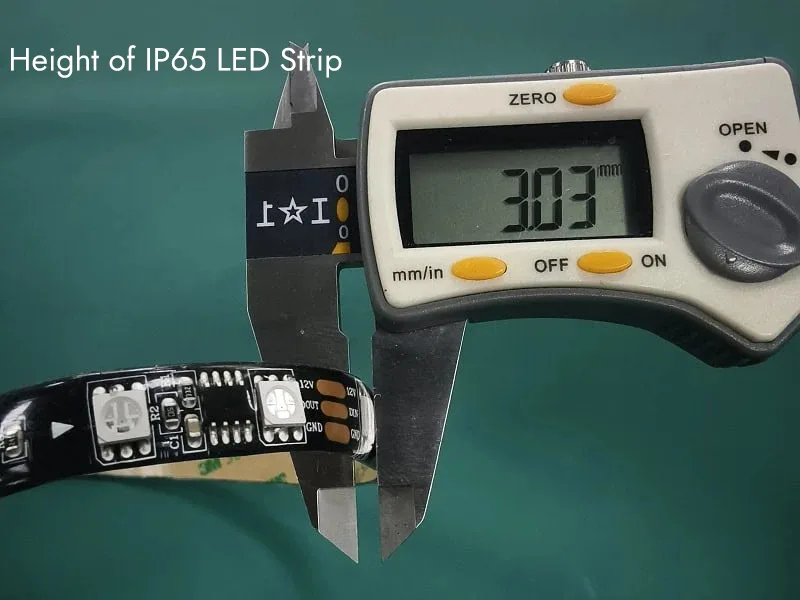
IP68(硅胶管灌封)高度:5-8毫米。IP68 LED灯带采用耐用的硅胶或环氧树脂全封装。IP68 LED灯带非常适合户外和水下应用,例如喷泉和景观照明。
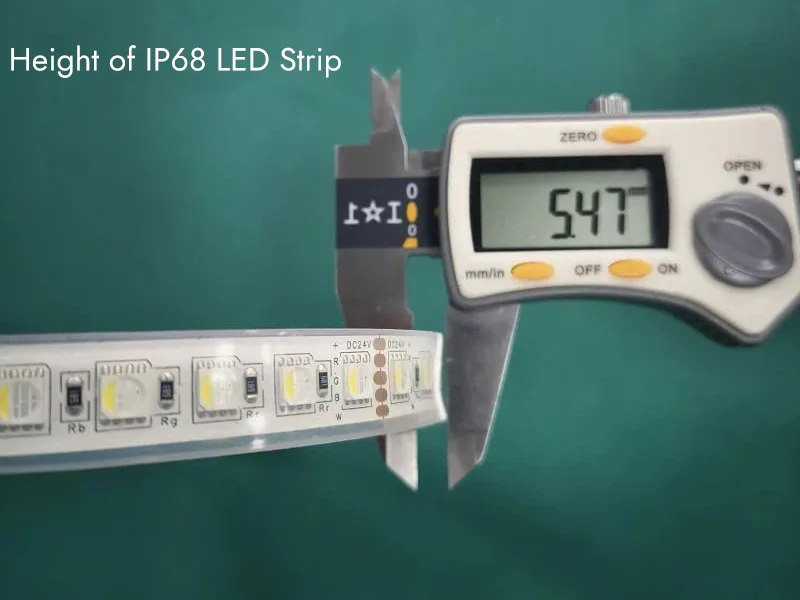
有关防水LED灯带的更多信息,请阅读“LED灯带防水IP等级指南。“ 和 ”选择户外防水LED灯带的6个步骤.”
如何为您的项目选择合适的 LED 灯带宽度?
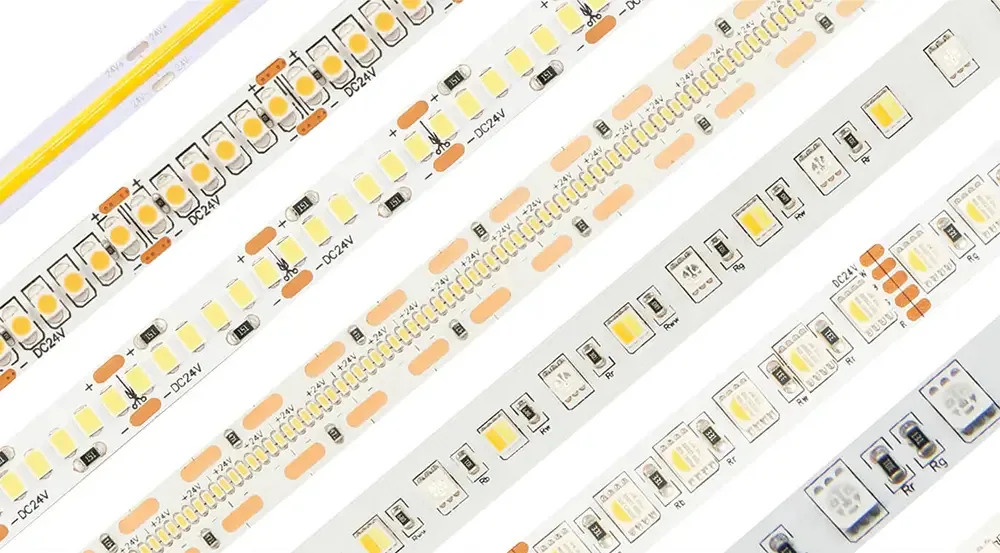
选择合适的 LED 灯带宽度,可确保您的照明项目兼具实用性和美观性。因此,选择 LED 灯带宽度时,请考虑空间限制、所需亮度和预期用途。窄灯带适合狭小空间,而宽灯带亮度更高,更适合较大区域。请仔细考虑以下建议:
1.了解你的项目需求:在选择 LED 灯带宽度之前,请评估项目的具体需求。确定 LED 灯带的安装位置。您需要 5 毫米超窄 LED 灯带(用于狭窄的缝隙)还是更亮的 20 毫米 LED 灯带(用于更大的区域)?
2. 空间限制:空间可用性在确定合适的宽度方面至关重要。对于紧凑的空间,例如橱柜内或搁板下方,请选择较窄的宽度,例如 8 毫米或 10 毫米。这些纤薄的外形可以无缝融入狭小空间,而不会显得笨重。
3. 所需亮度等级:项目所需的亮度级别也会影响您的选择。更宽的灯带(例如 15 毫米和 20 毫米)每单位长度可以容纳更多 LED,从而提供更高的亮度。它们非常适合需要高照明的区域,例如厨房或工作场所。
4.具体申请要求:考虑 LED 灯带的具体用途。例如,如果您计划为住宅环境提供氛围照明,10 毫米的灯带可能就足够了。但是,对于需要稳定照明的商业应用,更宽的灯带可能更合适。
5.安装注意事项:安装要求不容忽视(例如电源和安装选项)。一些较宽的灯带由于能耗较高,可能需要额外的硬件或电源考虑。
总而言之,选择合适的LED灯带宽度需要平衡物理空间、所需的光输出和实际安装因素。通过评估这些方面,您可以确保您的选择符合项目的功能和美学目标。
更宽的 LED 灯带是否更耗电?
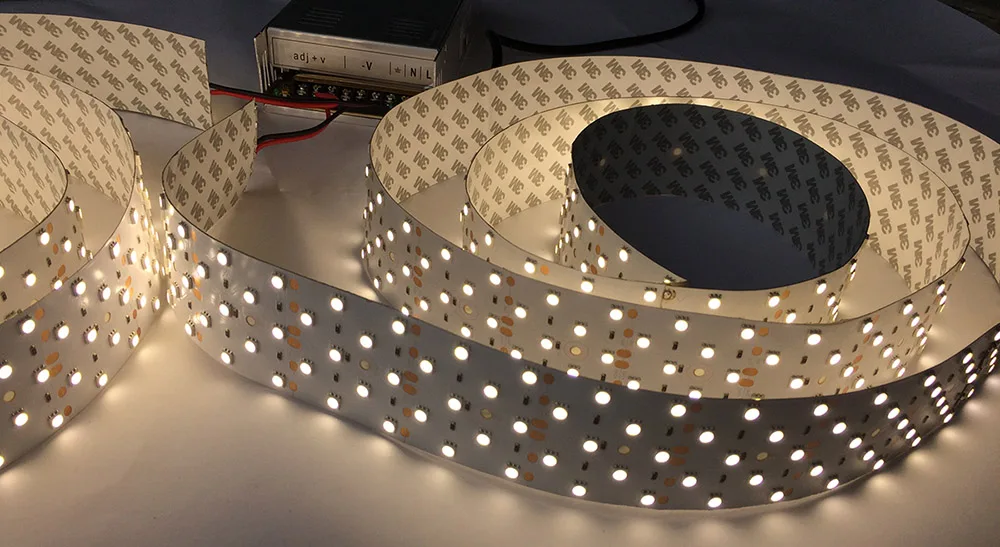
更宽的LED灯带并不一定更耗电。这取决于LED的密度、芯片尺寸、质量和电源。主要原因如下:
- LED芯片类型:灯带使用的LED芯片类型和质量对能耗有显著影响。在相同亮度下,更高效、更先进的LED芯片能耗更低。
- LED密度:单位长度的 LED 数量会影响能耗。LED 密度越高,通常意味着 LED 数量越多,从而导致能耗更高。
- 额定功率:LED灯带的额定功率以瓦特/米(W/m)为单位,表示每米LED灯带所消耗的电量。额定功率越高,通常能耗也就越高。
- 操作 在电压:LED 灯带的工作电压也会影响能耗。LED 灯带通常提供不同的电压选项,例如 12VDC 或 24VDC。电压较高的灯带通常需要的电流较低,因此更节能。
具体来说,LED芯片越大,功耗也就越大。例如,10mm 的 SMD5050 LED 灯带比相同宽度的 SMD2835 LED 灯带功耗更大。同样,如果两条 SMD2835 LED 灯带密度相同,但一条宽 5mm,另一条宽 10mm,并不一定意味着宽的那条功耗更大。在这种情况下,LED 灯带的宽度与功耗没有直接关系。
有关 SMD2835 与 SMD5050 LED 灯带的更多信息,请阅读“SMD3528、SMD2835 和 SMD5050:哪种 LED 灯带最适合商业和建筑照明?”
然而,正如我之前提到的,较大芯片的LED灯带确实比较小芯片的LED灯带耗电更多。但差别很小。例如,对于每米密度为60个LED的2835和5050 LED灯带,其功耗如下:
| LED芯片 | 每芯片功率 | 每米功率(60LED数量/米 LED 灯带 |
| SMD2835 | 0.2瓦 | 12瓦 |
| SMD5050 | 0.24瓦 | 14.4瓦 |
如上表所示,LED灯带每米的平均功率差异仅为2瓦多一点。虽然这确实会影响功耗,但对长期成本计算的影响并不大。
此外,LED灯带的密度越高,需要的LED芯片数量就越多,从而导致功耗更高。换句话说,一条10毫米宽、每米60颗LED的LED灯带比一条10毫米宽、每米30颗LED的LED灯带耗电量更大。
因此,虽然更宽的LED灯带可能包含更多LED,从而可能带来更高的能耗,但情况并非总是如此。您需要考虑上述关键因素。因此,请务必检查产品规格,并选择符合您所需亮度和能效标准的LED灯带。
结论
选择合适的 LED 灯带宽度对于项目的成功至关重要。选择时,请仔细考虑空间、亮度和应用需求。每种宽度都提供不同的功能,从柔和的重点照明到大面积的强光照明,应有尽有。在每个项目中,美观或功能性要求都取决于 LED 灯带宽度的合理选择:从紧凑的 8 毫米到更宽的宽度,总有一款解决方案能够满足您的所有需求。
无论您的照明项目需要多宽的 LED 灯带,SignliteLED 都是您的终极解决方案。我们提供各种 SMD LED灯带 和 COB LED灯带 满足您的需求。此外,我们还提供定制、OEM 和 ODM 服务。立即联系我们,获取您所需的 LED 灯带宽度!
